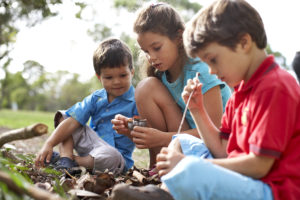By David Mullen
National Youth Sports Week began on July 15, and the experts at the Children’s Health Andrews Institute are dedicated to getting children outdoors to play and stay healthy while doing so. National Youth Sports Week aims to promote safe environments and healthy lifestyles for children and their families through sports and has officially been added to the National Health Observances calendar.

Photo courtesy of Cazzypopsblog
Children’s Health looks at subjects like sports sampling, overspecialization, summer heat safety, the mental stress of tryouts and weight lifting guidelines for younger athletes among other subjects. Dr. Troy Smurawa, director of pediatric sports medicine for orthopaedics and sports medicine and Dr. John Polousky, medical director at the Children’s Health Andrews Institute, are part of the team.
“It seems as though we have gone to — society as a whole — being afraid to have kids play outside,” Dr. Polousky said. “Playing unsupervised. There are probably a lot of reasons that are overblown for that. As a general rule, everything has become extremely organized for kids. Even for small children, parents set up ‘play days.’ It is all hyper-organized. Kids don’t have time allotted or a comfort level from their parents to free play. I think that was something that we all had growing up.”
“A rubber ball and a cardboard box could create hours of fun,” Dr. Polousky said. “Today, there is pressure to perform all of the time. As far as what we can do [to get kids outside and active], that is a big question. I think parents would do well to let their kids to do a lot of sports sampling, instead of just focusing on soccer or swimming or baseball, if for no other reason than for general neuro-muscular development. Most of the overuse injuries we see have to do with tendons and ligaments from overuse.”
“The concern is that we have seen a polarization,” Dr. Smurawa said. “On one end, there are athletes really involved in sports and they do that early specialization and are treated like professional athletes. They are on multiple teams and travel teams competing at an elite level trying to get college scholarships.
“On the other end, we see kids that aren’t participating in any sports. They are really not getting outside and staying inside with more sedentary activities like video games, which have become very popular activities.” Dr. Smurawa cited the eSports craze as an example. “In sports medicine, we are now focusing on injuries that can happen in eSports.”
According to a report, the eSports market has boomed in recent years with more and more viewers tuning in to watch their favorite games being played by some of the best gamers in the world. By 2022, there are expected to be almost 300 million frequent viewers of eSports worldwide, a vast increase from the 58 million in 2012.
“Kids that may not be as gifted or talented as other athletes,” Dr. Smurawa said, “and sometimes feel pressure to have to perform and do as well as those other athletes. So rather than being encouraged to play sports at a participation level, they are being pushed away from sports. So those kids that don’t participate in active sports are showing the signs of losing the benefits of exercise. They may be doing well in school, but they aren’t eating well.”
In the U.S., the percentage of children and adolescents affected by obesity has more than tripled since the 1970s. Data shows that nearly one in five school age children and young people (6 to 19 years) in the U.S. are obese.
Both Dr. Polousky and Dr. Smurawa are champions for kids playing multiple sports growing up. Dr. Smurawa sees a drop-off in participation on elite teams by age 13 because of specialization and kids simply burning out. “We see kids dropping out because of the pressures of specialization and that is a concern. They have the benefit of exercise and we want them to continue that into their adult years.”
If you can get the children out to play, Dr. Smurawa recommends loose clothing, avoiding prolonged exposure to the heat and wearing sunscreen. “The biggest thing is staying hydrated” Dr. Smurawa said. “We always recommend frequent fluid breaks.”
“The biggest motivation is what their friends are doing,” Dr. Polousky said. “If their friends are out playing, they are going to be out playing. It is as much a social interaction as it is an athletic one. That is one of the sad things about kids not getting together and playing without adult supervision. They sort of solve their difference with each other; there is negotiation and they judicate rules and decisions together.”
He also believes that parents should also limit video game play.
So it appears that the answer to getting children outside to play is that there is no specific answer.
Parents can lighten up on the organizational aspects, and children can be greatly influenced by their friends. Clearly, with an increasing child obesity problem and hours of video game play increasing exponentially, something has to be done.
